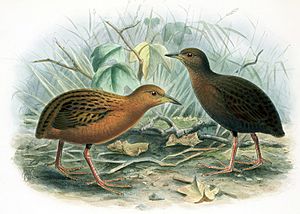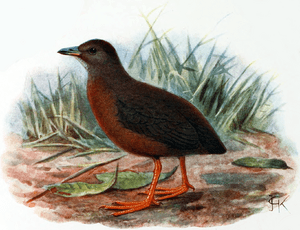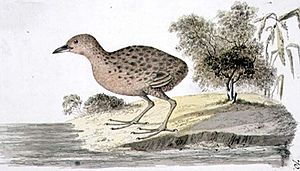Hawaiian rail facts for kids
The Hawaiian rail (Zapornia sandwichensis), also known as the Hawaiian spotted rail or Hawaiian crake, was a small, extinct bird that lived on the Big Island of Hawaiʻi. It was a type of rail, which are usually shy, ground-dwelling birds. This bird was special because it couldn't fly!
Scientists have found two different forms of the Hawaiian rail: one was dark, and the other was lighter with spots.
Quick facts for kids Hawaiian rail |
|
|---|---|
 |
|
| Light and dark form | |
| Conservation status | |
| Scientific classification | |
| Genus: |
Zapornia
|
| Species: |
sandwichensis
|
| Synonyms | |
|
|
Contents
About the Hawaiian Rail
For a long time, scientists were a bit confused about the Hawaiian rail. This was because there were two very different-looking forms of the bird. Some thought they might be different species, but it's now believed that the lighter, spotted birds were likely younger birds, while the darker ones were adults. Today, both forms are considered to be the same species.
The Hawaiian rail was about the size of a Laysan crake, which is a small bird.
What Was Its Name?
The native Hawaiian name for this bird was moho. This name was used for a small bird that "crows in the grass." There was also a name, iao or ʻiao, which might have referred to the lighter form of the Hawaiian rail or another small, extinct rail.
The moho was even mentioned in an old Hawaiian proverb: ʻAʻohe mea nāna e hoʻopuhili, he moho no ka lā makani. This means "nothing can blow him off course, he is like a moho in the wind." This proverb was used to praise someone who was brave and determined, because the flightless moho wasn't bothered by strong winds. It's important not to confuse the Hawaiian rail (moho) with the Moho birds, which were also from Hawaiʻi and are now extinct, but were completely different types of birds.
What It Looked Like
The first Hawaiian rails collected by explorers were of the lighter, spotted form. Later, darker birds were also found. Today, you can find specimens of the Hawaiian rail in museums around the world, including New York City, London, Vienna, and Honolulu.
In 1778, an artist named William Ellis painted a light Hawaiian rail while he was with Captain James Cook on his third voyage. Scientists have also found subfossil bones of these birds, which are bones that are not fully fossilized.
Where It Lived
The Hawaiian rail was a flightless bird, meaning it could not fly. It lived in shrublands and old, abandoned fields. When it felt in danger, it would hide in burrows made by Polynesian rats.
These birds were found in the middle elevations of what is now the Puna district on the Big Island, near the area of Mountain View. This was below the main rainforests.
Why It Disappeared
The last time a Hawaiian rail was reliably seen was in 1884, though there was a doubtful sighting in 1893. A special search for the bird in 1887 didn't find any, but because the bird was very good at hiding, it was hard to know for sure if they were all gone.
The Hawaiian rail likely became extinct because of animals brought to the island by humans. These included European rats, cats, and possibly dogs. These animals hunted the rails, which couldn't fly away to escape.
It's interesting to note that other threats, like the small Asian mongoose and mosquitoes (which carry diseases like fowlpox and avian malaria that are deadly to Hawaiian birds), didn't arrive on the Big Island until after the Hawaiian rail was likely already gone.
Hunting by humans probably wasn't a big reason for its extinction. The bird was protected by a kapu, which was a traditional Hawaiian law that said only aliʻi (chiefs) could hunt it. This kapu was abolished in 1819, but even after that, not many specimens were collected, suggesting it wasn't hunted a lot.
Images for kids
See also
 In Spanish: Polluela hawaiana para niños
In Spanish: Polluela hawaiana para niños







